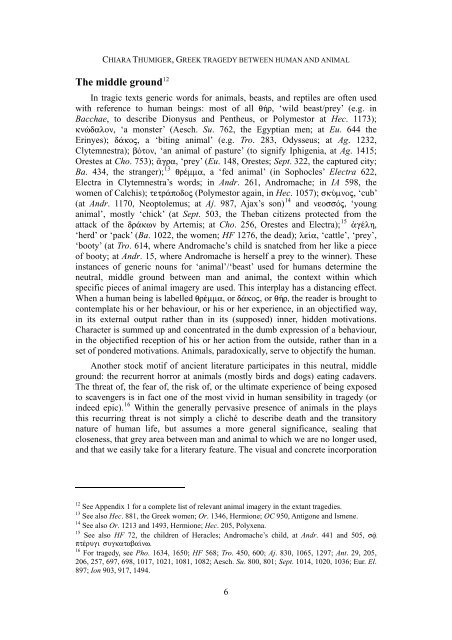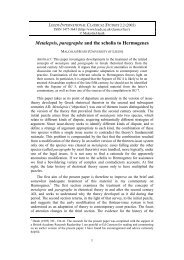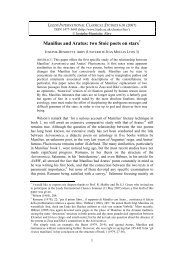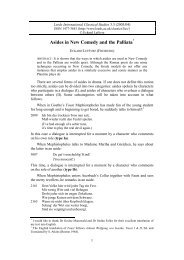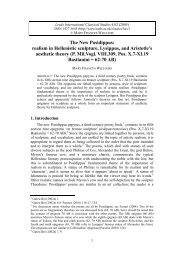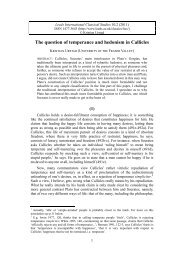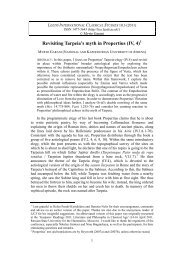Greek Tragedy between Human and Animal - Leeds International ...
Greek Tragedy between Human and Animal - Leeds International ...
Greek Tragedy between Human and Animal - Leeds International ...
Create successful ePaper yourself
Turn your PDF publications into a flip-book with our unique Google optimized e-Paper software.
CHIARA THUMIGER, GREEK TRAGEDY BETWEEN HUMAN AND ANIMAL<br />
The middle ground 12<br />
In tragic texts generic words for animals, beasts, <strong>and</strong> reptiles are often used<br />
with reference to human beings: most of all q»r, ‘wild beast/prey’ (e.g. in<br />
Bacchae, to describe Dionysus <strong>and</strong> Pentheus, or Polymestor at Hec. 1173);<br />
knèdalon, ‘a monster’ (Aesch. Su. 762, the Egyptian men; at Eu. 644 the<br />
Erinyes); d£koj, a ‘biting animal’ (e.g. Tro. 283, Odysseus; at Ag. 1232,<br />
Clytemnestra); bÒton, ‘an animal of pasture’ (to signify Iphigenia, at Ag. 1415;<br />
Orestes at Cho. 753); ¥gra, ‘prey’ (Eu. 148, Orestes; Sept. 322, the captured city;<br />
Ba. 434, the stranger); 13 qršmma, a ‘fed animal’ (in Sophocles’ Electra 622,<br />
Electra in Clytemnestra’s words; in Andr. 261, Andromache; in IA 598, the<br />
women of Calchis); tetr£podoj (Polymestor again, in Hec. 1057); skÚmnoj, ‘cub’<br />
(at Andr. 1170, Neoptolemus; at Aj. 987, Ajax’s son) 14 <strong>and</strong> neossÒj, ‘young<br />
animal’, mostly ‘chick’ (at Sept. 503, the Theban citizens protected from the<br />
attack of the dr£kwn by Artemis; at Cho. 256, Orestes <strong>and</strong> Electra); 15 ¢gšlh,<br />
‘herd’ or ‘pack’ (Ba. 1022, the women; HF 1276, the dead); le…a, ‘cattle’, ‘prey’,<br />
‘booty’ (at Tro. 614, where Andromache’s child is snatched from her like a piece<br />
of booty; at Andr. 15, where Andromache is herself a prey to the winner). These<br />
instances of generic nouns for ‘animal’/‘beast’ used for humans determine the<br />
neutral, middle ground <strong>between</strong> man <strong>and</strong> animal, the context within which<br />
specific pieces of animal imagery are used. This interplay has a distancing effect.<br />
When a human being is labelled qršmma, or d£koj, or q»r, the reader is brought to<br />
contemplate his or her behaviour, or his or her experience, in an objectified way,<br />
in its external output rather than in its (supposed) inner, hidden motivations.<br />
Character is summed up <strong>and</strong> concentrated in the dumb expression of a behaviour,<br />
in the objectified reception of his or her action from the outside, rather than in a<br />
set of pondered motivations. <strong>Animal</strong>s, paradoxically, serve to objectify the human.<br />
Another stock motif of ancient literature participates in this neutral, middle<br />
ground: the recurrent horror at animals (mostly birds <strong>and</strong> dogs) eating cadavers.<br />
The threat of, the fear of, the risk of, or the ultimate experience of being exposed<br />
to scavengers is in fact one of the most vivid in human sensibility in tragedy (or<br />
indeed epic). 16 Within the generally pervasive presence of animals in the plays<br />
this recurring threat is not simply a cliché to describe death <strong>and</strong> the transitory<br />
nature of human life, but assumes a more general significance, sealing that<br />
closeness, that grey area <strong>between</strong> man <strong>and</strong> animal to which we are no longer used,<br />
<strong>and</strong> that we easily take for a literary feature. The visual <strong>and</strong> concrete incorporation<br />
12<br />
See Appendix 1 for a complete list of relevant animal imagery in the extant tragedies.<br />
13<br />
See also Hec. 881, the <strong>Greek</strong> women; Or. 1346, Hermione; OC 950, Antigone <strong>and</strong> Ismene.<br />
14<br />
See also Or. 1213 <strong>and</strong> 1493, Hermione; Hec. 205, Polyxena.<br />
15<br />
See also HF 72, the children of Heracles; Andromache’s child, at Andr. 441 <strong>and</strong> 505, s´<br />
ptšrugi sugkataba…nw.<br />
16<br />
For tragedy, see Pho. 1634, 1650; HF 568; Tro. 450, 600; Aj. 830, 1065, 1297; Ant. 29, 205,<br />
206, 257, 697, 698, 1017, 1021, 1081, 1082; Aesch. Su. 800, 801; Sept. 1014, 1020, 1036; Eur. El.<br />
897; Ion 903, 917, 1494.<br />
6


